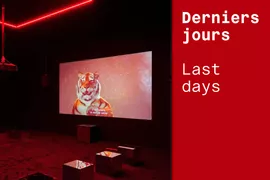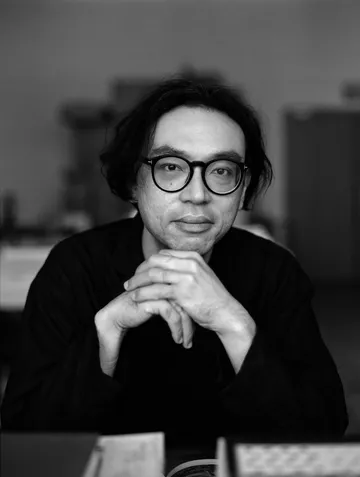One-person exhibitions of his work have been held at the Hessel Museum of Art (2024), Art Sonje Center (2024), Museum of Contemporary Art Tokyo (2024), Singapore Art Museum (2023), Hammer Museum (2022), Toyota Municipal Museum of Art (2021), Crow Museum of Asian Arts (2021), Yamaguchi Center for Arts and Media [YCAM] (2021), Edith-Russ-Haus for Media Art (Oldenburg, 2019), Kunstverein in Hamburg (2018), Ming Contemporary Art Museum [McaM] (Shanghai, 2018), Asia Art Archive (2017), Guggenheim Bilbao (2015), Mori Art Museum, (2012), The Substation (Singapore, 2003). He represented the Singapore Pavilion at the 54th Venice Biennale (2011).

Ho Tzu Nyen : Phantom Day and Stranger Tales
La Mécanique Générale
From
to
Ho Tzu Nyen is a Singaporean artist, filmmaker, and theatremaker who is considered as one of the most innovative artists to emerge internationally in the past 20 years.
Rooted in the historical and cultural contexts of East and Southeast Asia, Ho creates compelling video installations that employ a range of techniques to probe and complicate the borders between reality and myth, history and fiction. Jour spectral et contes étranges [Phantom Day and Stranger Tales] features five multimedia installations that span more than a decade of Ho's practice.
From usage of lens and camera, to found footage, animation, algorithmic editing systems and Artificial Intelligence processes, Ho's technical experiments are deployed in a critical examination of how histories–state, cultural, or personal–are continually imagined, constructed, negotiated, and performed. Drawing from the heterogeneity of cultures in the region of Southeast Asia, his works simultaneously invoke and unravel a vast range of subjects, from pre-colonial myths to colonial encounters, to the convolutions of modern geopolitics, to representations of a hybridized and unstable present. Ho is a storyteller, constantly reshaping his stories, but also the means by which he tells them. As a result, themes, motifs and protagonists from one work migrate into another, forming an often hallucinatory world. A sense of this may be glimpsed from the diagram on the left, which was originally the script of Ten Thousand Tigers, a theatrical piece he wrote and directed in 2014, and which continues to resonate with his latest works.
At the center of the exhibition is the latest addition to Ho's world, Phantoms of Endless Day, an installation commissioned for the show at LUMA Arles. This work draws on material from Endless Day–a feature film project begun in 2011 and which has remained unfinished until today, but whose themes and characters would haunt his video installations and films over the next decade. Using a series of artifical intelligence (AI) processes to edit, sequence, and recreate the images and sounds from the original materials of the unfinished feature film, Phantoms of Endless Day plunges us into a series of alternative timelines, blurring the lines between myth, memory, history and fantasy. Characteristic of Ho's interdisciplinary approach, the installation challenges conventional understandings of time, perception, and storytelling.
The new work can be seen as Ho's attempt to close the loop, and develop a hybrid form of cinematic language using the latest possibilities of algorithmic and AI filmmaking. The outcome is a hallucinatory, tropical gothic experience, in which AI generated voices, rather than telling a story, suggest a multiplicity of different possible stories.
Phantoms of Endless Day is an attempt to redeem and re-dream the past into new, possible futures. Continuing Ho's signature exploration of fragmented histories, philosophical inquiry, and narrative complexity, it becomes a remarkable new lens, through which to experience his distinctive set of visual and aural tales. Along with some of the artist's other groundbreaking works, such as The Nameless (2015), The Name (2015), One or Several Tigers (2017), Hotel Aporia (2019), and T for Time (2023-ongoing) gathered here, this exhibition reveals a practice that is embedded in a complex and interconnected universe, one which gives rise to works that resist passive viewing, inviting instead a form of experiencing that is simultaneously emotional, intellectual, fluid, and endlessly generative.
Ho Tzu Nyen
Steeped in numerous Eastern and Western cultural references ranging from art history to theatre and from cinema to music to philosophy, Ho Tzu Nyen’s works blend mythical narratives and historical facts to mobilise different understandings of history, its writing and its transmission. The central theme of his œuvre is a long-term investigation of the plurality of cultural identities in Southeast Asia, a region so multifaceted in terms of its languages, religions, cultures and influences that it is impossible to reduce it to a simple geographical area or some fundamental historical base. This observation as to the history of this region of the world is reflected in his pieces which weave together different regimes of knowledge, narratives and representations. From documentary research to fantasy, his work combines archival images, animation and film in installations that are often immersive and theatrical.
